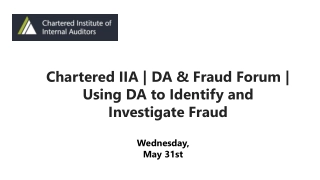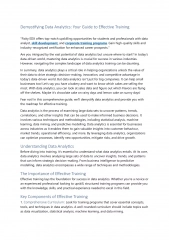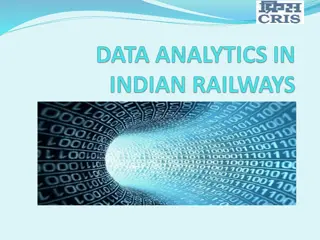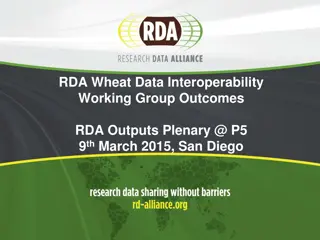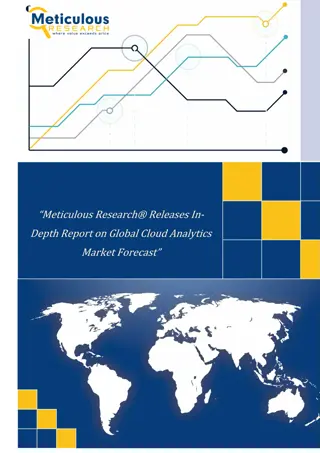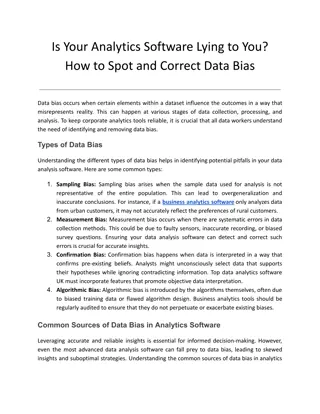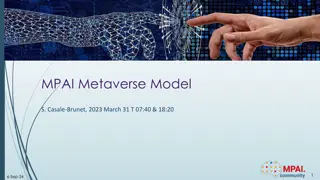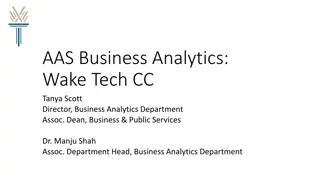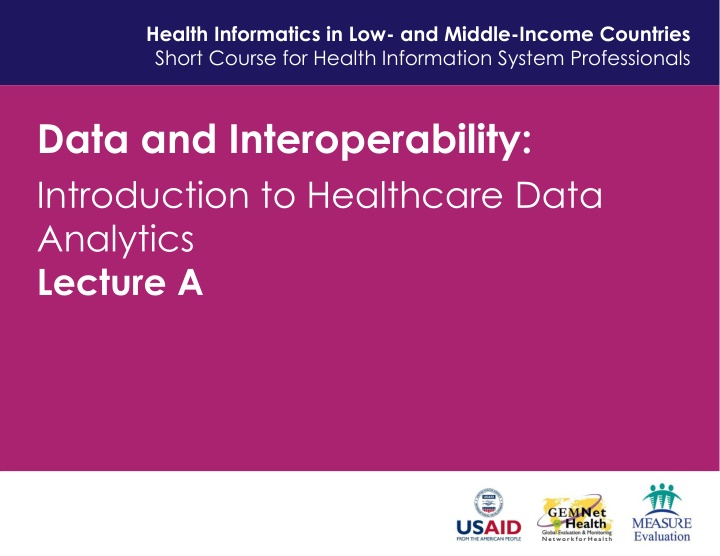
Introduction to Healthcare Data Analytics in Low- and Middle-Income Countries
Explore the world of healthcare data analytics with a focus on low- and middle-income countries. Understand the importance of data elements, the data analytics process, and the role of clinical data warehouses in improving healthcare systems. Dive into the essential concept of data elements and their significance in achieving semantic interoperability for better computer understandability.
Download Presentation

Please find below an Image/Link to download the presentation.
The content on the website is provided AS IS for your information and personal use only. It may not be sold, licensed, or shared on other websites without obtaining consent from the author. If you encounter any issues during the download, it is possible that the publisher has removed the file from their server.
You are allowed to download the files provided on this website for personal or commercial use, subject to the condition that they are used lawfully. All files are the property of their respective owners.
The content on the website is provided AS IS for your information and personal use only. It may not be sold, licensed, or shared on other websites without obtaining consent from the author.
E N D
Presentation Transcript
Health Informatics in Low- and Middle-Income Countries Short Course for Health Information System Professionals Data and Interoperability: Introduction to Healthcare Data Analytics Lecture A
Introduction to Healthcare Data Analytics Learning Objectives Lecture A Give a basic overview of data analytics in healthcare Give a basic overview of data elements and their attributes Describe the nine steps of the data analytics process 2
Introduction Information is the oil of the 21st century, and analytics is the combustion engine. Peter Sondegaard, Senior Vice President and Global Head of Research for Gartner 3
The Big Picture of Patient Data Multiple systems in a health information system These systems are designed for clinical use and reporting purposes None has a complete set of data for o Individual patients o Groups of patients o All aspects of a health information system 5
Clinical Data Warehouse Aggregates data for a patient from multiple sources Used for analysis and reporting, not clinical care Requires an extraction- transform-load process For analysis and reporting For clinical use (patient care) Claims data: Billing System Device data Prescription data: Pharmacy System Clinical Data Warehouse Providers notes Extraction Transform Load (ETL) process Order and Result Data: Radiology Information System Information and Knowledge Order and Result Data: Laboratory Information System EHR Perioperative Data (Smith, 2016) 6
A Data Element Is The atomic unit of data that is finely grained and has a precise meaning Level at which data are created and collected o Level that is necessary to define clinical models and input for clinical decision making Level at which data elements can be precisely, uniquely, and unambiguously defined, that is independent of use, location, and circumstance What simplifies achieving semantic interoperability Essential for computer understandability 6
Data Elements and Terminology What is a data element and what is a terminology? Is diagnosis a data element or a terminology? Any and every concept is a data element 7
What is analytics? The discovery of meaningful patterns in data, and is one of the steps in the data life cycle of collection of raw data, preparation of information, analysis of patterns to synthesize knowledge, and action to produce value. (National Institute of Standards and Technology [NIST], 2015) 21
What is analytics? Entire process of data collection, extraction, transformation, analysis, interpretation, and reporting 22
What is analytics? Analytics is used to refer to the methods, their implementations in tools, and the results of the use of the tools as interpreted by the practitioner. The analytics process is the synthesis of knowledge from information. (NIST, 2015) 23
Types of Analytics: Overview Descriptive: Uses business intelligence and data mining to ask: What has happened? Predictive: Uses statistical models and forecasts to ask: What could happen? Prescriptive: Uses optimization and simulation to ask: What should we do? (IBM Software, 2013) Diagnostic:Examines data to answer Why did it happen? (Gartner IT Glossary, 2015) 24
Types of Analytics: Overview (Gartner, 2012) 25
Descriptive Analytics Describe the data Common statistics: Counts Averages Typical reporting methods: Tables Pie charts Column/bar charts Written narratives (Gartner, 2012) 26
Diagnostic Analytics Attempts to answer why did it happen? Drill-down techniques Data discovery Correlations (Gartner, 2012) 27
Predictive Analytics Predicts instead of describing or classifying Rapid analysis Relevant insights Ease of use (Gartner, 2012) 28
What Predictive Analytics Cannot Do The purpose of predictive analytics is NOT to tell you what will happen in the future. It cannot do that. In fact, no analytics can do that. Predictive analytics can only forecast what might happen in the future, because all predictive analytics are probabilistic in nature. (Bertolucci, 2013) 29
Prescriptive Analytics Examines data or content to answer the question What should be done? or What can we do to make _______ happen? Is characterized by techniques such as: Graph analysis Simulation Complex event processing Neural networks Recommendation engines Heuristics Machine learning (Gartner, 2012) 30
Steps in Data Analytics 1. Identify the problem and the stakeholders 2. Identify what data are needed and where those data are located 3. Develop a plan for analysis and a plan for retrieval 4. Extract, transform, load the data 5. Check, clean, and prepare the data for analysis 6. Analyze and interpret the data 7. Visualize the data 8. Disseminate the new knowledge 9. Implement the knowledge in the organization 31
1. Identify the Problem or Question and the Stakeholders Why is this an important problem? How will the results impact patient care or the institution? What is the business case? Who are the stakeholders? 32
2. Identify What Data Are Needed What data elements, such as date of birth, gender, medications, laboratory results, and so on, are needed? Where are these data elements located in which system or systems and which database tables? Is there a clinical data warehouse? Who is the contact person for each system who will be responsible for retrieving the data? 33
3. Develop Plans for Retrieval and Analysis Retrieval Enlist database administrator for each system Develop specific plan for retrieving the required data elements Method for cross-checking number of records as well as completeness how many should you expect and did you get everything? Analysis Enlist statistician Identify population, sample size, statistical tests to be performed 34
4. Extract, Transform, Load Process Extraction May be an iterative process The data are retrieved Checked for completeness Descriptive statistics Errors corrected, empty fields addressed Transformation Data synchronized ( transformed ) (e.g., M, F, U vs. 1, 2, 9) Loading Data then imported into destination system 35
5. Check, Clean, and Prepare the Data Data are now in the system where analysis will be run Should be a complete set of data Need to check that everything is ready for analysis Descriptive statistics Double-check problem or question being investigated Double-check against analysis plan 36
6. Analyze and Interpret the Data Use the data analysis plan Perform the actual statistical analyses as described in the plan Consult with statistician to confirm interpretations and conclusions 37
7. Visualize the Data Nominal (categorical) data: column or bar charts, tables, pie charts, pivot tables Quantitative data: histograms, scatter plots, star plots Examples of tools Microsoft Excel Chart function Tableau PIE CHART HISTOGRAM 38 (Innesw, 2014, CC BY-NC-SA 3.0)
8 and 9: Disseminating and Implementing Disseminating the new knowledge o Write up the findings o Disseminate to the stakeholders Implementing the new knowledge o Requires participation of stakeholders 39
For Additional Information For more information on these topics, read these articles: Six Steps of an Analytics Project by Jaideep Khanduja The Seven Key Steps of Data Analysis by Gwen Shapira 40
Introduction to Healthcare Data Analytics Summary Lecture A Analytics is the entire process of data collection, extraction, transformation, analysis, interpretation, and reporting. It can be categorized into three types: descriptive, predictive, and prescriptive. 28
Introduction to Healthcare Data Analytics References Lecture A References American Health Information Management Association. (2012). Managing a data dictionary. Journal of AHIMA, 83(1), 48-52. Retrieved from http://library.ahima.org/PB/DataDictionary#.WI9uCVMrJhE Bertolucci, J. (2013). Big data analytics: Descriptive vs. predictive vs. prescriptive. InformationWeek. Retrieved from http://www.informationweek.com/big-data/big-data- analytics/big-data-analytics-descriptive-vs-predictive-vs-prescriptive/d/d-id/1113279 Dictionary.com. (n.d.). Nominal scale. Retrieved from http://www.dictionary.com/browse/nominal-scale Escobar, G. J., Puopolo, K. M., Wi, S., Turk, B. J., Kuzniewicz, M. W., Walsh, E. M., ... & Draper, D. (2014). Stratification of risk of early-onset sepsis in newborns 34 weeks gestation. Pediatrics, 133(1), 30-36. Retrieved from http://pediatrics.aappublications.org/content/pediatrics/133/1/30.full.pdf Gartner. (2011, October 17). Gartner says worldwide enterprise IT spending to reach $2.7 trillion in 2012. Retrieved from http://www.gartner.com/newsroom/id/1824919 Gartner IT Glossary. (2015). Descriptive analytics. Retrieved from http://www.gartner.com/it- glossary/descriptive-analytics 29
Introduction to Healthcare Data Analytics References Lecture A References Gartner IT Glossary. (2015). Diagnostic analytics. Retrieved from http://www.gartner.com/it- glossary/diagnostic-analytics IBM. (2013). Descriptive, predictive, prescriptive: Transforming asset and facilities management with analytics. Retrieved from http://www-01.ibm.com/common/ssi/cgi- bin/ssialias?infotype=SA&subtype=WH&htmlfid=TIW14162USEN Institute of Medicine of the National Academies. (2012). Best care at lower cost: The Path to continuously learning health care in America. Washington, DC: Institute of Medicine of the National Academies. Retrieved from http://www.nationalacademies.org/hmd/Reports/2012/Best-Care-at-Lower-Cost-The-Path-to- Continuously-Learning-Health-Care-in-America.aspx Institute of Medicine of the National Academies. (n.d.). The learning health care system in America. Retrieved from http://www.nationalacademies.org/hmd/Activities/Quality/LearningHealthCare.aspx Khanduja, J. (2015). Six steps of an analytics project - Quality assurance and project management. (2015). Quality Assurance and Project Management. Retrieved from http://itknowledgeexchange.techtarget.com/quality-assurance/six-steps-of-an-analytics- project/ 30
Introduction to Healthcare Data Analytics References Lecture A References Mayo Clinic. (2016). Overview - Sepsis. Retrieved from http://www.mayoclinic.org/diseases- conditions/sepsis/home/ovc-20169784 Murdoch, T., & Detsky, A. (2013). The inevitable application of big data to health care. JAMA, 309(13), 1351. http://dx.doi.org/10.1001/jama.2013.393 National Institute of Standards and Technology (NIST). (2015). NIST big data interoperability framework: Volume 1, definitions. Gaithersburg, MD: NIST. Retrieved from http://nvlpubs.nist.gov/nistpubs/SpecialPublications/NIST.SP.1500-1.pdf National Institutes of Health. (2015). What is big data? Retrieved from http://datascience.nih.gov/bd2k/about/what NIST/SEMATECH e-Handbook of statistical methods. (n.d.). Retrieved May 02, 2016, from http://www.itl.nist.gov/div898/handbook/ Sas.com. (2016). What is Hadoop? Retrieved from http://www.sas.com/en_my/insights/big- data/hadoop.html Schneeweiss, S. (2014). Learning from big health care data. New England Journal of Medicine, 370(23), 2161-2163. Retrieved from http://www.nejm.org/doi/full/10.1056/NEJMp1401111#t=article Shapira, G. (2016). The seven key steps of data analysis. Oracle.com. Retrieved from http://www.oracle.com/us/corporate/profit/big-ideas/052313-gshapira-1951392.html 31
Introduction to Healthcare Data Analytics References Lecture A Figures Smith, K. (2016). Clinical data warehouse. Used with permission from Kimberly Smith. Gartner IT Glossary. (2012). Predictive analytics. Retrieved from http://www.gartner.com/it- glossary/predictive-analytics Images Farcaster. (2014). Data visualization process v1 [online Image]. Retrieved April 28, 2016, from https://commons.wikimedia.org/wiki/File:Data_visualization_process_v1.png#/media/File:Data_v isualization_process_v1.png Innesw. (2014). Simple pie chart [online Image]. Retrieved May 2, 2016, from https://commons.wikimedia.org/wiki/File%3ACharts_SVG_Example_5_-_Simple_Pie_Chart.svg 32
This material was developed by The University of Texas Health Science Center at Houston, funded by the Department of Health and Human Services, Office of the National Coordinator for Health Information Technology under Award Number 90WT0006. This presentation was produced with the support of the United States Agency for International Development (USAID) under the terms of MEASURE Evaluation cooperative agreement AID-OAA-L- 14-00004. MEASURE Evaluation is implemented by the Carolina Population Center, University of North Carolina at Chapel Hill in partnership with ICF International; John Snow, Inc.; Management Sciences for Health; Palladium; and Tulane University. Views expressed are not necessarily those of USAID or the United States government. www.measureevaluation.org

